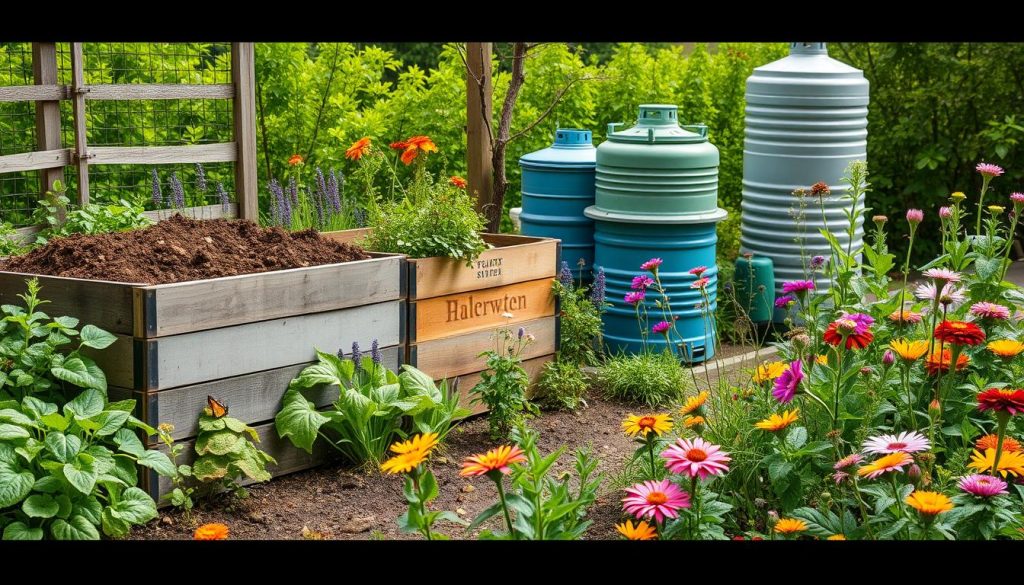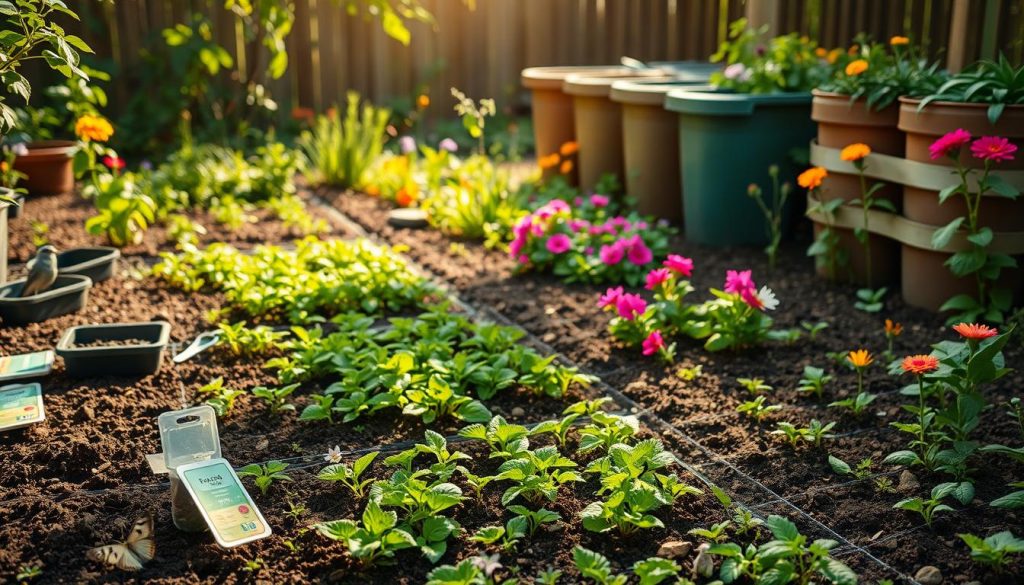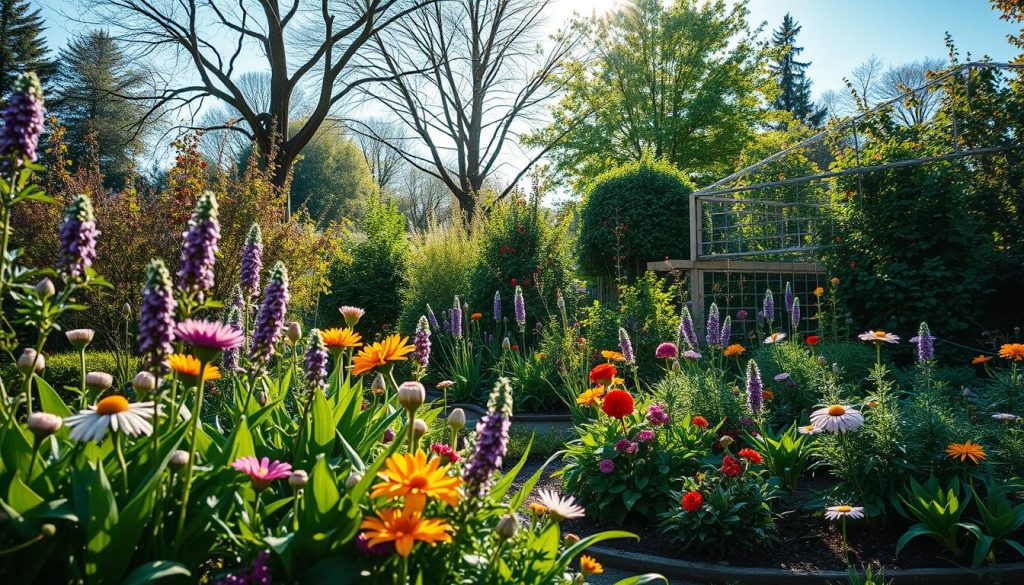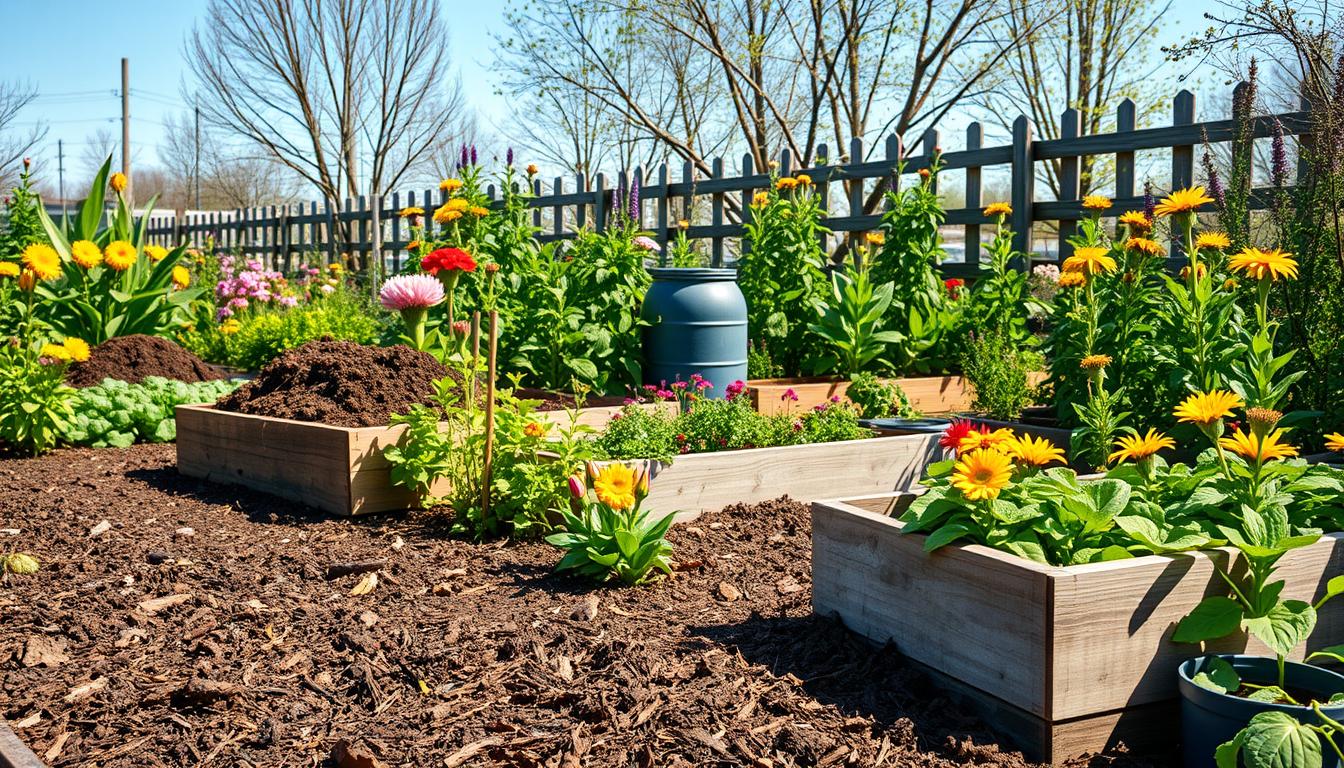As I get my garden ready for spring, I focus on eco-friendly ways. This means using methods that help my garden and the planet. I’m excited to share how you can make your garden green and healthy.
I’ll teach you the basics of sustainable gardening and share useful tips. My aim is to help you create a sustainable garden for spring. I’m excited to share my knowledge and journey with you.
Understanding Sustainable Gardening Principles
Exploring sustainable gardening is exciting. It’s all about creating a balanced ecosystem that works with nature. By using natural and organic methods, I can avoid chemical products and make my garden better for the environment.
Sustainable gardening is great for the environment. Techniques like using rainwater and compost save water and improve soil. Green gardening methods, like planting together and rotating crops, boost biodiversity and plant health.

- Using natural and organic methods to maintain the garden
- Reducing water consumption through efficient irrigation systems
- Improving soil health through the use of compost and mulch
- Increasing biodiversity by planting a variety of native plants and flowers
By following these principles, I can make a beautiful and thriving garden. It will benefit me and the environment. Next, I’ll look at how to check my garden’s winter condition and find ways to improve it.
Assessing My Garden’s Winter Condition
To get my garden ready for spring, I need to check its winter condition. I’ll look at the soil health, spot any pests, and see which plants made it through winter. This helps me figure out what to do to prepare for the new growing season. I aim to do this in an eco-friendly way, focusing on sustainable yard care.
First, I’ll examine the soil for erosion or nutrient loss. I’ll also search for pests that might have shown up over winter. This will guide me in making my garden more earth-friendly. I’ll check for:
- Soil pH levels to ensure they’re right for my plants
- Pest damage, like holes in leaves or stems
- Soil that’s compacted or eroded
By carefully assessing my garden, I can plan for a sustainable yard care approach. This will include using natural fertilizers and compost. I’ll also pick plants that fit my local climate.
Checking Soil Health
Soil health is key in my garden assessment. It helps me spot nutrient gaps or pH imbalances. Fixing these issues will make my garden a better place for my plants to grow.
Identifying Pest Issues
Finding pests is also vital for a healthy garden. It lets me act fast to stop more damage and plan for green pest control. I’ll consider natural methods, like introducing beneficial insects or using barriers to keep pests away.
Planning My Spring Garden Layout
As I start planning my spring garden, I focus on making it thrive and diverse. I choose which plants to grow and where to put them. I also aim to use my space wisely. Eco-friendly gardening tips, like companion planting and crop rotation, help me do this.
First, I think about the plants I want to grow and how they can help each other. Companion planting is key here. It lets me create a balanced garden ecosystem. For example, marigolds can keep nematodes away from tomatoes, and basil can make lettuce taste better.
- Planting marigolds with tomatoes to deter nematodes
- Pairing basil with lettuce to improve its flavor
- Growing beans with corn to provide support and shade
Crop rotation is also crucial in my garden planning. It helps avoid soil nutrient depletion and pest issues. By rotating plants, I make my garden healthy and low-maintenance.

Using these eco-friendly tips, I aim to create a garden that’s both beautiful and productive. It will give me fresh food and help the local ecosystem. I’m looking forward to seeing how these practices will benefit my garden and the environment.
Selecting Native and Sustainable Plants
When planning my garden, I focus on eco-friendly landscaping. Choosing native plants is key to a sustainable garden. These plants need less care and water, and they fight off pests better.
I pick plants that fit my area’s climate and soil. This choice helps local wildlife and saves water and chemicals. Native plants are good for the soil and the planet.
Looking for the right plants, I think about sunlight, soil, and moisture. This way, my garden is easy to care for and uses less resources. 
Benefits of Native Plants
Native plants are great for gardens and the environment. They feed and shelter local animals, helping the ecosystem. They also keep the soil healthy, cutting down on fertilizers and pesticides.
How to Choose Sustainable Varieties
To find sustainable plants, I look for ones native to my area. I also consider their growth, when they bloom, and any pest issues. This helps my garden thrive with little care.
Implementing Eco-Friendly Gardening Practices
To make your yard sustainable, start with eco-friendly gardening tips. Organic fertilizers are key. They help soil health and cut down on chemical use. This way, you can make your garden a green haven.
Think about collecting rainwater for plants, cutting down on waste, and using natural garden prep. These steps are good for your garden and the planet. For instance, rainwater saves money and keeps waterways clean.
- Compost to make soil better and reduce waste
- Native plants that need less care
- Flowers and shrubs that attract pollinators
Adding these green practices to your gardening can make your outdoor space beautiful and eco-friendly. It’s good for you and the planet.
Creating a Wildlife-Friendly Environment
I’ve learned how key it is to make my garden a haven for wildlife. Using eco-friendly gardening and landscaping, I help local animals thrive. This makes my garden more beautiful and diverse.
I’ve built birdhouses and insect hotels to give homes to different animals. I also plant flowers that bees and butterflies love. Sunflowers, zinnias, and lavender are my go-to choices. This way, my garden is both lovely and good for the planet.
- Providing a source of water, such as a birdbath or pond
- Creating a diverse range of habitats, including trees, shrubs, and grasses
- Avoiding the use of pesticides and herbicides, which can harm local wildlife
By following these tips, I make my garden a better place for both me and the wildlife. Sustainable gardening, eco-friendly landscaping, and green techniques help create a thriving ecosystem.
Timing My Planting and Preparation
As I finish my sustainable spring garden prep, timing is key. Knowing the local frost dates and following planting best practices is crucial. This ensures my garden gets off to a great start.
I’ll wait until after the last frost to plant my seedlings and annuals. This step prevents damage and lets my plants grow strong roots. I’ll also make sure to space them right and water and feed them well as they grow.
With my soil ready, plants picked, and timing set, I’m all set for a thriving garden. These eco-friendly gardening tips will lead to a rich harvest and a beautiful outdoor space. It will also attract local wildlife.
Being patient and flexible is important. Nature can surprise us, and I’m eager to see my garden grow. With some care, I’ll have a green, productive, and eco-friendly garden to enjoy all year.

